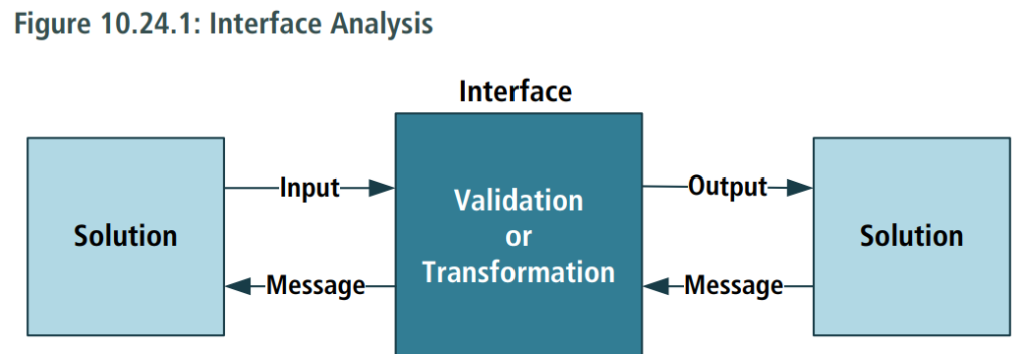10.24.1 Purpose
Interface analysis is used to identify where, what, why, when, how, and for whom information is exchanged between solution components or across solution boundaries.
10.24.2 Description
An interface is a connection between two components or solutions. Most solutions require one or more interfaces to exchange information with other solution components, organizational units, or business processes.
Interface types include:
- user interfaces, including human users directly interacting with the solution within the organization,
- people external to the solution such as stakeholders or regulators,
- business processes,
- data interfaces between systems,
- application programming interfaces (APIs), and
- any hardware devices.
Interface analysis defines and clarifies the following:
- who will use the interface,
- what information is being exchanged through the interface, as well as the volume of the data,
- when information will be exchanged and how frequently,
- where the information exchange will occur,
- why the interface is needed, and
- how the interface is or should be implemented.
The early identification of interfaces allows the business analyst to provide the context for eliciting more detailed stakeholder requirements, thus determining adequate functional coverage of the solution to meet stakeholder needs. Early identification of interfaces reveals which stakeholders will benefit from or depend on the various components of the solution, which can help the business analyst determine which stakeholders should be present for other elicitation techniques.

10.24.3 Elements
.1 Preparing for Identification
The business analyst can leverage other techniques, such as document analysis, observation, scope modelling, and interviews, in order to understand which interfaces need to be identified. A context diagram can reveal high-level interfaces between human actors, organizational units, business processes, or other solution components. The results of this analysis can reveal how frequently any existing interfaces are being used and any problems with them that may strengthen the case for change. The results may also help identify any key issues that need to be resolved in order for an interface solution to be created.
.2 Conduct Interface Identification
Business analysts identify what interfaces are needed in the future state for each stakeholder or system that interacts with the system. The relationship between stakeholders and interfaces can be many-to-many or, in some cases, one-to-one.
Some interfaces may be less obvious or less frequent such as an interface used for regulatory functions or auditing, or for employee training. Identified interfaces can include interfaces from solutions other than the operational solution.
For each interface, business analysts:
- describe the function of the interface,
- assess the frequency of the interface usage,
- evaluate which type of interface may be appropriate, and
- elicit initial details about the interface.
.3 Define Interfaces
Requirements for an interface are primarily focused on describing the inputs to and outputs from that interface, any validation rules that govern those inputs and outputs, and events that might trigger interactions. There may be a large number of possible interaction types, each of which needs to be specified. Interactions may be triggered by the typical or alternate flow of inputs and outputs in the business solution, or by exceptional events such as failures.
Business analysts consider who will use the interface, what information is passed over the interface, and when and where the interface takes place. The interface defines user workflow between systems, user roles and privileges, and any management objectives for the interface. Interface definition is dependent upon usability guidelines, such as accessibility requirements or general workflow requirements.
In order to identify any major design issues, interfaces between solution or process components and people require detailed analysis of the interface to be conducted upfront. Interface definition includes:
- the name of the interface,
- the coverage or span of the interface,
- the exchange method between the two entities,
- the message format, and
- the exchange frequency.
10.24.4 Usage Considerations
.1 Strengths
- By engaging in interface analysis early on, increased functional coverage is provided.
- Clear specification of the interfaces provides a structured means of allocating requirements, business rules, and constraints to the solution.
- Due to its broad application, it avoids over analysis of fine detail.
.2 Limitations
- Does not provide insight into other aspects of the solution since the analysis does not assess the internal components.
